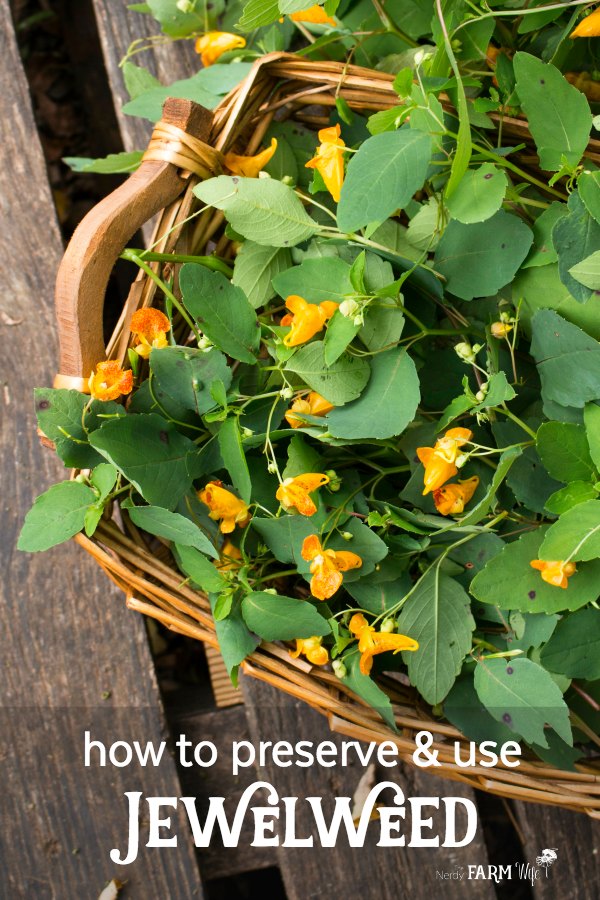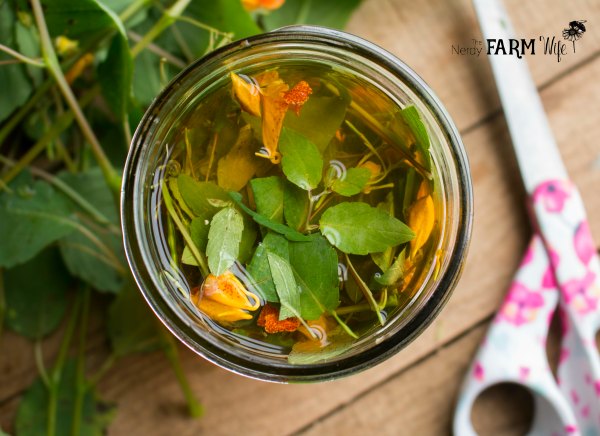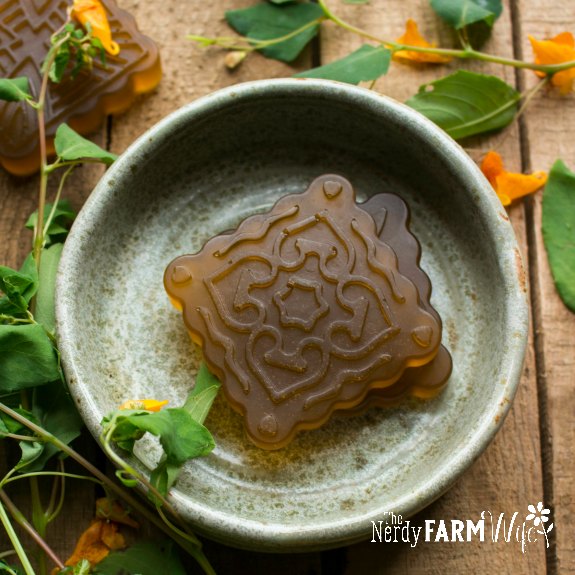Preserving & Using Jewelweed (6 Uses!)
Jewelweed is an excellent natural remedy for poison ivy, poison oak, bug bites, and general itchy skin conditions.
If you’re fortunate to have any growing around you, be sure to harvest some now to preserve for year ’round use!

Lately there’s been an increase in reader interest and questions about jewelweed, so today I’m sharing how to make “jewelweed juice”, how to preserve it in vinegar, plus how to make two kinds of jewelweed soap (one cold process and one melt & pour) and more project ideas shared below.
This post may contain affiliate links. That means if you click on one and purchase something, I earn a small commission for sending a customer their way.
Foraging for Jewelweed (Impatiens capensis)
Jewelweed, a pretty annual wildflower, also called spotted touch-me-not, balsam weed, slipper weed, and more, enjoys growing in moist shady spots. I usually find it growing not far from the couple of creeks that cut through our property.
For information in identifying jewelweed, check out this article I wrote over at our family site:
It’s fine to use the flowers in your jewelweed concoctions, but the good stuff is mainly found in stems and leaves.
The earlier in the season that you pick jewelweed, the more juice it may have available.
Ways to Preserve & Use Jewelweed
1. Make & Freeze Jewelweed Juice
My favorite way to preserve jewelweed is to puree with some water, strain, and freeze the resulting juice in ice trays.
You can either thaw a portion for several hours in the refrigerator, or lightly rub a frozen cube directly over itchy spots as needed.
How much water you add to the mix is really up to you and how juicy your plant is. You might need more water later in the season.
Add enough to make blending easy and to ensure you have a good supply of juice.

2. Make Jewelweed Infused Vinegar
This vinegar is helpful to keep on hand for itchy skin flares and it doesn’t require refrigeration.
Directions to Make:
- Coarsely chop fresh jewelweed and place in a jar, filling 1/2 to 3/4 of the way, lightly packing as you go.
- Pour apple cider vinegar over the fresh plant matter until the jar is filled.
- Stir a few times with a chopstick or knife to release any air bubbles.
- Cover with a plastic cap, or place a few layers of plastic wrap or parchment paper between a metal lid and the jar. This forms a barrier that prevents the vinegar from corroding the metal top over time.
- Allow to infuse for 2 to 3 weeks, then strain into a clean jar.
- Cover with a plastic cap, label, and store until needed. Shelf life is about one year.
To use jewelweed vinegar: Saturate a cotton ball with the infused vinegar and gently rub over itchy spots. Allow to air dry on your skin. Apply as needed for relief. Extra sensitive skin types may want to dilute with water before use.

3. Natural Jewelweed Soap Recipe (Cold Process)
This recipe comes straight from the pages of my Simple & Natural Soapmaking print book.
(Don’t have a copy yet? Visit Amazon or your local bookseller to buy it today!)
If plantain isn’t available, you could use violet, chickweed, or comfrey leaves instead, or just add extra jewelweed to the mix.
Oil, water, and lye amounts are all measured by weight. You must use an accurate scale to make soap.
Ingredients for Jewelweed Soap (Cold Process)
- 1 cup chopped fresh jewelweed
- 1 cup chopped fresh plantain
- 8.75 oz (248 g) distilled water
- 3.95 oz (112 g) sodium hydroxide (lye)
- 1 teaspoon chlorella powder (from Mt Rose Herbs)
- 8 oz (227 g) coconut oil (28.5%)
- 12 oz (340 g) olive oil (43%)
- 4 oz (113 g) rice bran oil (or more olive) (14.25%)
- 4 oz (113 g) sunflower or sweet almond oil (14.25%)
- 1.06 oz (30 g) lavender essential oil (optional)
Directions to Make Cold Process Jewelweed Soap
(This is a brief summary of directions – please see my Soap Making 101 article for more details on making your own soap.)
- Blend the jewelweed and plantain together with 2 ounces of water until fully pureed.
- Add the rest of the water and stir well.
- Place the mixture in the refrigerator to infuse for several hours or overnight.
- Remove and strain the resulting greenish-brown juice.
- Weigh out 8.5 oz for use in the soap, adding more distilled water as needed.
- Wearing gloves & protective eyewear, carefully stir the lye into the chilled jewelweed/plantain juice.
- Stir in the chlorella powder.
- The lye solution may develop an unpleasant skunk-like smell; this is normal and won’t last.
- Set the lye solution in a safe place to cool for about 30 to 40 minutes, or until it reaches around 100 to 110°F.
- Warm the oils to 100 to 110°F, then blend in the cooled lye solution.
- Using a combination of hand stirring and an immersion blender, stir the soap until it reaches trace.
- Stir in the lavender essential oil, if using, then pour into a prepared mold.
- Cover and allow to remain in the mold for at least 24 hours, or until it can be removed easily.
- Cut into bars and cure for at least 4 to 6 weeks.

4. Jewelweed Soap Recipe (Using Melt & Pour Soap Base)
This recipe is from my print book, Easy Homemade Melt & Pour Soaps.
It’s a super easy method to make jewelweed soap with no handling of lye required!
Ingredients for Melt & Pour Jewelweed Soap
- ¼ cup (9 g) chopped fresh jewelweed
- 1 tbsp (15 ml) water
- 8 oz (227 g) clear soap base, cut into 1″ (2.5-cm) cubes
- ½ tsp finely ground oats or colloidal oats
- 0.45 g (~⅛ tsp) lavender essential oil (optional)
- Silicone mold (X-Haibei 6-cavity mooncake mold pictured)
- Rubbing alcohol, for spritzing
Directions to Make Melt & Pour Jewelweed Soap
- In a heatproof jar or container, combine the chopped jewelweed, water and soap base and cover loosely with a canning lid or heatproof saucer.
- Place the jar in a saucepan containing a few inches (at least 5 cm) of water, forming a makeshift double boiler.
- Heat over medium-low heat until the soap is almost melted, 15 to 25 minutes, then stir the mixture and lower the heat to low.
- Gently infuse for an additional 25 to 30 minutes, or until the base is completely melted and has turned a greenish brown color.
- Remove from the heat and stir in the oats.
- Strain the hot soap mixture through a fine-mesh sieve into a clean container or jar, then stir in the lavender essential oil (if using).
- Pour into the soap molds and spray the top with alcohol.
- Let cool until completely hardened, 2 to 3 hours.
- Remove from the molds and wrap tightly.
- Label and store in a cool, dry spot out of direct sunlight.
5. Jewelweed as a Dye
I haven’t tried it yet, but this tutorial on using jewelweed as a natural dye also looks fun to try!
6. Jewelweed Salve
It’s most effective when used fresh, so I generally don’t dry jewelweed for oil infusions.
However, you can infuse oil with fresh chopped jewelweed stems, leaves, and flowers simmered over low heat, then turn that infused oil into a salve.
You can find my recipe for jewelweed salve over at my article:
How to Forage for Jewelweed + Uses
And there you have it! I hope you enjoyed learning these 6 ways to use jewelweed!



Excellent Ideas, You could add a simple decoction of Witch Hazel AND Jewel Weed….fill a wide mouth Mason Jar with Stem’s and Leaves of Jewel Weed, fill to the brim with Witch Hazel set in a cool dry place for a week.Rotate daily. When done get some small plastic dollar store bottles with the flip tops (1 Mason Jar = 7 or 8 bottles) Great for a carry along when you are out and about. I worked at a Kid’s camp for a number of years and it was a life savor….and if you get the kid’s helping you make it…..a great lesson to take with them for a long time
Hi Robert, That’s absolutely wonderful! Thanks so much for sharing with us! :)
What a wonderful article, thank you. I’m going to check ouy your book too!
Hi Sherryl, Thank you so much! I appreciate you checking out the book too! :)